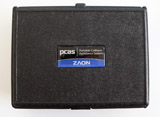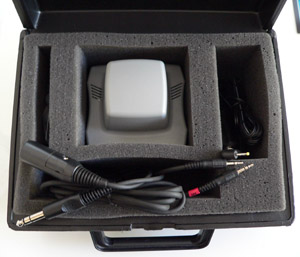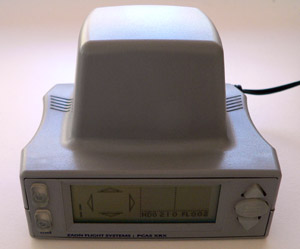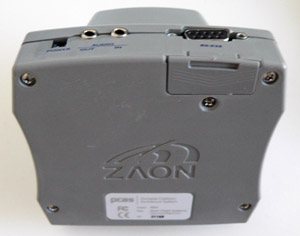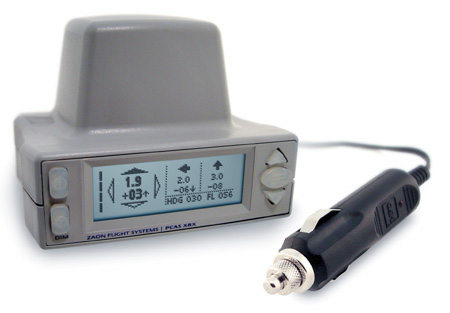 Watching Your Six Never Was Easier…We have reviewed a number of Portable Collision Avoidance Systems (PCAS) from Zaon. We had the opportunity to flight test their latest model in traffic detection systems which not only includes information on relative altitude and range but also in which direction to look for traffic, in other words quadrant bearing. The ZaonFlight XRX is a huge improvement over their previous top model and well worth the investment in making your skies safer. Have a look at why we think so.
Watching Your Six Never Was Easier…We have reviewed a number of Portable Collision Avoidance Systems (PCAS) from Zaon. We had the opportunity to flight test their latest model in traffic detection systems which not only includes information on relative altitude and range but also in which direction to look for traffic, in other words quadrant bearing. The ZaonFlight XRX is a huge improvement over their previous top model and well worth the investment in making your skies safer. Have a look at why we think so.
Previous models from Zaon/SureCheck were already masters in detecting conflicting traffic within your bubble of airspace up to 6 miles away but you still had to swivel your head 360° to see where the threat was coming from.
Nearby traffic could well be behind you and closing in and in most aircraft there is a huge blind spot underneath, above and behind you and no matter how good someone’s scan is there is unseen traffic all around us. And I want to know about it…
The XRX has a directional antenna array which is capable of detecting aircraft from inside the cockpit and indicate from which 45° segment the threat is coming from.
ZaonFlight, as far as we know, is the only company in the world to have developed a portable system that can do this. To get directional information on nearby traffic on other systems you would have to invest about 10 times the amount you pay for the XRX.
Let’s talk a bit more about the technology as well as the capabilities and limitations of this PCAS system.
The XRX is a passive collision avoidance system. This means that it depends on the interrogation of ground-based radar stations and/or TCAS active systems along your flight path. With ground radar having a coverage of typically 200 miles plus and aircraft based TCAS covering a bubble around them of some 100 miles, there is not a lot of airspace where the XRX doesn’t pick up any traffic. That applies certainly to the USA but also to more sparsely populated areas such as here in Australia.
The zaonflight.com website has some excellent background material on how exactly the transponder interrogation takes place and so do their promotional material and the excellently written manual
|
|
|
Installation
The XRX is shipped in a hard carrying case which also contains several silicone mounting feet to level the XRX out on your dashboard. You’ll also find here the power adapter to plug it into your ship’s system and an audio cable so that you can hear any warnings immediately through your headset. The female voice is certain to get your attention even if the unit is not directly mounted in your line of sight. The XRX can be mounted at a 45° angle on the co-pilot’s glare shield but needs to be “re-calibrated” (a simple process) for that position. Ideally it is directly in front of you but the dash in our pressurised 210 is just a fraction too high to have the box mounted there and interferes with seeing the piano keys on final approach. Needless to say the company is also working on offering a panel mounted solution with a remote antenna as they are doing for all their systems.
This is what Jason Clemens, CEO at Zaon, said to me: “For MRX [the new version of the TrafficScope Micro – Ed.], the install kit will be available mid-April, and it will be very inexpensive. For XRX, it’s much more complex than MRX, involving a remote screen, and remote-mounted custom-produced antennas. We are expecting to unveil the beta version at Oshkosh (July), with production units available by October. For pilots in the US, the first version will not be FAA certified… The market will be homebuilts and experimentals. However, we are working with the FAA to get an STC’d version out at close to the same time.”
It is of course extremely handy to have a portable system if you rent your aircraft. Just make sure that that new Cessna has a power point…
 |
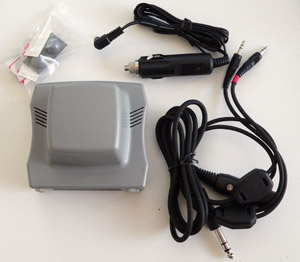 |
Fan Noise
One of the first things you’ll hear when switching on the XRX is the little fan that keeps the thing cool. Of course you know about the big fan upfront that is supposed to keep you cool but this little fella is quite essential to keep the electronic happy on that hot, hot dashboard. As I mentioned in my previous review the VRX did not have inbuilt cooling and on sunny days I would have to shield the box from overheating. It did not help that the box was black either which absorbs even more heat. The only advantage of the unit being black is that it doesn’t glare in your windshield but the new XRX, “resplendent” in dull grey, is equally easy on the eyes.
The fan noise is not something you’ll hear in flight. If you do, you’ll have a problem…
The Zaon XRX is easy to set up. It’s basically a question of power hook-up, connecting the audio cables if you want to and away you go. Unless you have a pressurised aircraft in which case you need to open up a little plastic hatch on the bottom which gives access to two sets of configuration switches. This needs to be done because the XRX has an internal altimeter. This gives the local altitude and establishes a base reference to figure out the relative altitude of other aircraft. When I fly in our pressurised 210 the unit bypasses the built-in altimeter and relies on the transmission from my own transponder to get the base reference.
Before you start flying you need to indicate on the menu screen whether you are flying a high or a low wing metal aircraft and also set the range and altitude of your airspace bubble. The type of wing configuration in metal airplanes determines the amount of antenna pattern compensation the XRX applies. No compensation is needed with composite aircraft. There is a bit of a blind spot in detecting traffic in metal aircraft right behind the tail. They have done some tests in the most popular airplanes and the schematic below gives a good indication of the area that is shielded in our P210.
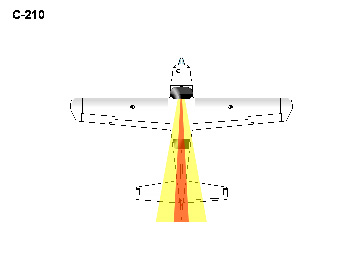
Display
The monochrome display is very readable in most situations, also at night even though it’s not dimmable. I would have preferred a colour screen in a higher resolution, something like an OLED display, which is a very common and affordable technology today. Colour can also indicate different types of warnings and urgencies.
Perhaps a colour screen for a 3-1/8″ round mount for the dashboard mounted unit?
The traffic screen contains the target information of the three nearest threats, with the most acute threat displayed in bigger numbers. You will know instantly how far the other aircraft are, whether they are above or below you or cruising along at your altitude. In addition, you have a trend indication to show whether they are climbing or descending relative to you. The XRX also indicates which direction your head should turn to detect the incoming traffic. No nervous swiveling to spot the bogey which could upset your passengers. Instead, you can impress them with your incredible eyesight: “Can you see that aircraft on our right? He is about 5 miles out and heading straight for us!”
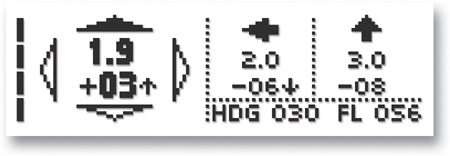
Ayers Rock
Some years ago I was doing a charter flight taking a bunch of tourists from Italy on an Outback tour of Australia. Two weeks in the saddle, covering some of the harshest and most stunning geography this continent has to offer. Yes, we also did the obligatory aerial tour of Ayers Rock. With dozens of aircraft circling this massive monolith and the nearby Olgas Range it can be a crowded place. From the radio chatter I knew that the Boeing 737 which I had seen at Alice Springs before, and which carried some US senators, was ahead of me in the circuit. He would be circling the Olgas and head straight for me just 500 feet below… you can be sure that my plane was lit up like a Christmas tree as I literally sat on the edge of my seat trying to spot that aircraft and avoid a diplomatic incident! That, my friends, is an XRX moment. I would have paid double the purchase price to have the peace of mind of knowing exactly where that sightseeing 737 was! Apart from those moments of apprehension it was kinda cool to fly above an aluminium “undercast”…
|
|
|
Testing, Testing
We have flown many hours with the PCAS units from SureCheck/Zaon and have become quite familiar with their potentially life-saving assistance in bringing nearby traffic to your attention. All these units work as advertised, detecting all the transponder equipped aircraft around you, provided of course that those transponders have been switched on and are being interrogated by ground radar or active TCAS units. Most pilots will have a hard time believing there are that many other aircraft sharing your airspace, which is all the more reason to invest in a system with better eyesight than any other safety pilot on board.
With all these improvements over the previous model I am quite happy with the capability, performance, and reliability of the XRX. Sure, there will always be room for improvement, particularly in the area of display technology but that might have to wait till the XRXi model comes out…
Recognition and Reaction Times
Where the XRX really shines is in detecting traffic that you would otherwise not know about: aircraft in your blind spots for instance. But even in optimal circumstances when visibility is unlimited, aircraft present such a small target that they are hard to spot if they are more than just a couple of miles away. With combined approach speeds of several hundred miles per hour we only have very few precious seconds to determine if we need to take evasive action. Page 44 in the XRX manual has a table of recognition and reaction times. From the moment we see an object and recognise it as an aircraft, to the time we conclude that we are indeed on a collision course, takes about six seconds. Then we need to decide to turn left or right, descend or climb, translate that into muscle movement and deal with the aircraft lag time. Add another 6 1/2 seconds. If your combined approach speeds would be 600 mph and you first spotted that converging aircraft two miles away you would be half a second into a midair collision…
We can see that early detection is absolutely critical. The XRX does not do away with the need to “see and avoid”. On the contrary, the XRX is a tremendous tool for traffic detection.

Third-Party Communications
The XRX has a very simple menu structure which makes it easy to set up. One screen, however, is intriguing: it’s the one for third-party communications setup.
It mentions TrueFlight and AnywhereMap. Now I have been a user of the AnywhereMap program ever since it came out a few years ago. It runs on a Pocket PC and is a brilliant moving map program. The US version has gone through quite a few changes and improvements but the rest of the world has been languishing for some years now, despite promises of catering to the European and Australian flying fraternity with updated databases. I have almost stopped using AnywhereMap in favour of other capable programs that are more up-to-date but I would go back to ControlVision’s AWM in a heartbeat if it were updated for the Aussie market. Particularly now that it will be possible in the near future to output data from the XRX onto the brilliant VGA screen of my iPAQ 4700. This is what Richard Herbst of CV mentioned in an e-mail recently: “We will approach the PCAS in two stages: as a standalone application/device which it currently is, and as an integrated system capable of showing its data on the Anywhere Map display.”
Here’s hoping…
An interesting footnote is that CV is supplying the injection-moulded cases for the XRX.
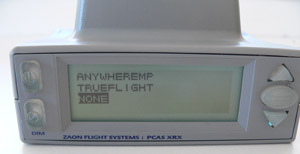
Firmware Upgrade
And while we’re looking to the future: the firmware in the XRX can be upgraded although it seems that these upgrades can only be performed in the US factory. Mine came with version 1 .3 installed so obviously we have already been through a few changes, all of them relatively minor. If Zaon expects many firmware upgrades over the lifetime of this model it would have been handier and cheaper to be able to do these online as you can readily do with the cheapest of MP3 players.
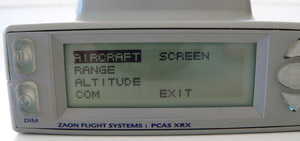
Comparisons and Pricing
Obvious improvements over the previous top-end model, the VRX, include the directional guidance, the addition of a fan for the electronics and a much smaller and lighter package. It’s amazing the difference in weight and that is a very good thing when it comes to placing heavy objects on your dashboard…
By leaving the batteries out and going from an all metal enclosure to plastic you already get quite a bit of weight reduction and ever decreasing electronic components certainly help also. The one thing it did gain was the directional antenna, but as I mentioned before, Zaon will also come out with a dashboard model that will have a remote mounted antenna.
If you can live without the antenna and the quadrant bearing guidance it provides, you may want to have a look at the new MRX. We hope to do so in the next review but let us tantalise you by saying that this thing is tiny… how about smaller than a deck of cards? Sure, it will only display the top threat, whereas the XRX can display the three nearest threats even though both units keep track of all the aircraft within your airspace bubble (that’s 5 or 6 miles around you).
The MRX is listed at USD549 and the XRX can be your new eyes in the skies for $1795.
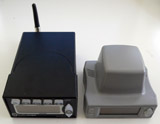
Some Background on the Name Change
It might be confusing if you are familiar with the models that SureCheck brought out in recent years to see that suddenly the XRX is coming out under the banner of Zaon. There is a good reason for it and here it is:
In the words of Jason Clemens: “In 2005, we split the SureCheck company into two parts: Zaon Flight Systems, the new company, handles all avionics, while SureCheck remains to handle our line of checklists and other publications. In fact, SureCheck continues to be the largest producer of aviation checklists in the world, selling over 50,000 checklists annually. Zaon (a combination of the two founder’s names), can wholly focus on the complex task of continuing the best-selling line of collision avoidance avionics.”
And best-selling they are: it the few months since releasing the new models Zaon has sold more than a thousand units already. This is good going in such a niche market.
I score this unit a healthy 9/10.
{nomultithumb}{module Banner – ZAON}


